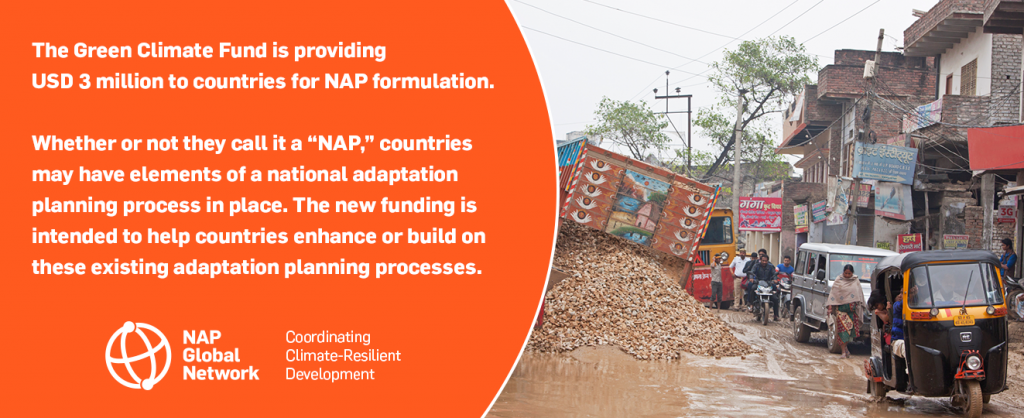
At its 13th meeting in Songdo, Republic of Korea, at the end of June, the Green Climate Fund (GCF) Board announced plans to provide financial support to developing countries for the formulation of national adaptation plans (NAPs) and/or other national adaptation planning processes.
Specifically, countries can now request up to USD 3 million in support through a new, dedicated NAP activity area under the GCF Readiness and Preparatory Support Program.
This new area of support for national adaptation planning is welcome news, but what exactly does it mean for countries in different stages of the NAP process? Here are some key take-away messages from this decision.
New funding is for NAP formulation, which is recognized as an enabler for effective implementation.
At this risk of stating the obvious, it is important to emphasize that this new support is specifically for NAP formulation and is meant to enhance a country’s readiness for the effective implementation of adaptation projects and programs. The implementation of priority adaptation projects and programs can already be supported under the GCF’s adaptation funding window.
That is, as a result of this specialized support, countries are expected to be better able to assess their vulnerabilities and devise plans that help them identify future priority actions.
NAP readiness funding is separate and additional to existing readiness funding.
The GCF decision notes that “funding for this new activity area is additional to the existing USD 1 million cap per country per year.”
The new NAP formulation funding of up to USD 3 million dollars also does not have a capped timeline.
Countries can use new funding to enhance or build on existing adaptation planning processes.
Countries already undertaking adaptation planning do not need to go back to the drawing board and start from scratch; whether or not they call it a “NAP,” countries may have elements of a national adaptation planning process in place. The new readiness funding can be used to build on or bolster this planning process, as needed, in order to prepare a country for the implementation of adaptation projects and programs.
That said, these funds are not intended to push countries to spend more time ‘perfecting’ their NAP – if planning is already underway or completed that demonstrates a country’s priorities and ownership, then countries can opt not to use this NAP readiness support and focus how to use what they already have advanced to develop a funding proposal to access GCF support for implementation.
The procedures for requesting NAP Support are the same as readiness and funding proposal approval processes
Readiness proposals for NAP support should be submitted by the national designated authorities (NDAs) either directly or in collaboration with the readiness delivery partners– the same procedure as applied to the readiness proposals.
Funding proposals for NAP support may be submitted by accredited entities with the no-objection letters from NDAs–the same procedure as the initial proposal approval process.
Programmatic or multi-country NAP formulation proposals can also be submitted
For some countries, $ 3 million might not be enough to address adaptation planning needs, or their needs may be better served by joining other countries as part of a larger program and benefit from cross-country learning. To address such cases, accredited entities will be able to put forward programmatic, multi-country proposals for formulating NAPs and/or other adaptation planning processes with the no-objection letters from countries covered in the proposals.
The new decision recognizes NAPs’ importance for strategic investment in climate resilience.
This GCF’s enhanced support for and emphasis on NAPs comes at a critical moment when many developing countries are engaged in national adaptation planning. This new support underscores the important role NAPs and/or national adaptation planning processes play as a vehicle for strategic investments in a country’s climate-resilient development.
To meet the adaptation challenge facing us in the coming decades, countries need plans that look beyond just short-term needs. NAPs exist to help us think bigger and choose priorities; now, thanks to the GCF, there are more resources than ever before to make it happen.
You can read the GCF’s full decision and more details about the Readiness and Preparatory Support Program as well as the Funding Proposal Approval process on the GCF’s website.

Any opinions stated in this blog post are those of the author and do not necessarily reflect the policies or opinions of the NAP Global Network, its funders, or Network participants.
Interested in joining the Network as a participant? Find out more.